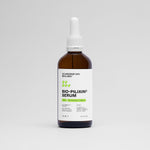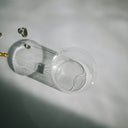Minoxidil is one of the most widely used hair loss treatments available today. Whether you're using it for male pattern baldness, female pattern hair loss, or other forms of alopecia, you might eventually wonder if you can stop the treatment. Perhaps you've achieved your desired results, are experiencing side effects, or simply don't want the ongoing commitment. This comprehensive guide will answer all your questions about discontinuing minoxidil and what to expect when you do.
Table of content
Can You Stop Using Minoxidil?
Yes, you can stop using minoxidil at any time. However, when you discontinue minoxidil, any hair growth that occurred as a result of the medication will likely be lost within 3-6 months. The hair follicles that became dependent on minoxidil will return to their previous state, potentially resulting in hair shedding and reverting to your pre-treatment hair pattern.
As your leading source for hair health information over the past 4 years, we never compromise on accuracy. When it comes to your health, you deserve information you can truly rely on - and earning your trust is our top priority.
Here's how Scandinavian Biolabs ensures every piece of content meets the highest standards of accuracy and integrity:
- Credentialed Experts: Our reviewers are actively practicing doctors and medical researchers
- Stringent Reviews: Content undergoes rigorous editing by subject specialists and review by a practicing doctor.
- Evidence-Based: We rely on well-established research from trusted scientific sources like peer-reviewed journals and health authorities.
- Full Transparency: Our editorial standards, writer credentials, reviewer credentials, correction process, and funding are all publicly documented.
- Independent Voice: While we do promote products, we operate in a vacuum to business operations. Our main goal is just an unwavering commitment to providing medically-sound guidance.
You can count on Scandinavian Biolabs to consistently deliver the trustworthy health information you deserve. Read our Editorial Standards.
What Happens When You Stop Using Minoxidil?
When you discontinue minoxidil, several changes typically occur over time:
1. Initial phase (1-2 weeks): You may not notice any immediate changes.
2. Shedding phase (2-8 weeks): Many users experience a period of increased hair shedding. This happens because hair follicles that were dependent on minoxidil begin to enter the telogen (resting) phase.
3. Regression phase (2-6 months): Gradually, your hair density will likely return to what it would have been without minoxidil treatment. This means you'll not only lose the gains made from minoxidil but potentially have less hair than when you started if natural hair loss progression continued during treatment.
Why Does Hair Fall Out After Stopping Minoxidil?
Hair loss after discontinuing minoxidil occurs because the medication works by artificially prolonging the growth phase of hair follicles and increasing blood flow to the scalp. When you stop applying it:
1. Blood vessels that were dilated by minoxidil return to their normal state, reducing nutrient and oxygen supply to hair follicles.
2. Hair follicles that were maintained by minoxidil lose their artificial support.
3. Follicles affected by androgenetic alopecia (pattern hair loss) resume their sensitivity to DHT (dihydrotestosterone), the hormone primarily responsible for pattern baldness.
4. The natural hair loss process that was temporarily halted by minoxidil resumes, often with a temporary acceleration known as "minoxidil shedding."
Can You Wean Off Minoxidil?
Some people wonder if gradually reducing minoxidil usage can help prevent the sudden shock of shedding. According to dermatologists and available research:
There is no scientifically proven method to wean off minoxidil that prevents eventual hair loss. Gradually reducing frequency (from twice daily to once daily, then every other day) might theoretically ease the transition, but the end result will likely be the same – minoxidil-dependent hair will eventually be lost.
Dr. Nicole Rogers, a board-certified dermatologist specializing in hair restoration, notes: "There's no evidence that tapering minoxidil prevents the eventual return to baseline. The hairs dependent on minoxidil will still be lost, just perhaps over a longer period."
How to Minimize Hair Loss When Stopping Minoxidil
If you've decided to stop using minoxidil, there are several strategies that may help minimize the impact:
1. Consider alternative treatments: Transitioning to another hair loss treatment before completely stopping minoxidil might help maintain some results. Options include:
- Finasteride (for men only, prescription required)
- Low-level laser therapy devices
- Anti-DHT shampoos and topicals
- Platelet-rich plasma (PRP) treatments
2. Support overall hair health: Focus on optimizing conditions for your remaining hair:
- Maintain a nutrient-rich diet with adequate protein, iron, zinc, and vitamins
- Manage stress levels
- Avoid harsh hair treatments and heat styling
- Consider supplements like biotin, saw palmetto, or specialized hair vitamins (though evidence for their efficacy varies)
3. Psychological preparation: Understanding that shedding will likely occur can help you prepare emotionally. Consider:
- Shorter hairstyles that may make thinning less noticeable
- Hair fibers or concealers as temporary cosmetic solutions
- Support groups for those dealing with hair loss
Who Should Consider Stopping Minoxidil?
Several situations might warrant discontinuing minoxidil treatment:
1. Side effect concerns: Some users experience:
- Scalp irritation, itching, or dermatitis
- Unwanted facial hair growth (particularly in women)
- Allergic reactions to minoxidil or vehicle ingredients
- Heart palpitations or dizziness (rare but serious side effects)
2. Treatment ineffectiveness: If after 12 months of consistent use you see:
- No noticeable improvement in hair density
- Continued significant hair loss despite treatment
3. Practical considerations:
- Financial constraints (lifetime treatment costs add up)
- Lifestyle changes making the twice-daily routine difficult
- Pregnancy or planned pregnancy (for women)
Long-Term Alternatives to Minoxidil
If you're looking for permanent solutions that don't require ongoing minoxidil application, consider:
1. Hair transplantation: FUE (Follicular Unit Extraction) or FUT (Follicular Unit Transplantation) provide permanent results by relocating DHT-resistant hair follicles from the back of the head to thinning areas.
2. Scalp micropigmentation: A cosmetic tattooing technique that simulates the appearance of hair follicles, creating the illusion of density or a closely-shaved look.
3. Acceptance approaches: Many people choose to embrace their natural hair loss pattern through:
- Shaving the head completely
- Styling strategies that work with thinning hair
- Hair pieces or wigs for those who desire full coverage
Can Any Hair Be Retained After Stopping Minoxidil?
This question has nuanced answers depending on individual circumstances:
1. Duration of use matters: Research suggests that long-term minoxidil users (5+ years) may retain some minoxidil-dependent hairs even after stopping. This is because:
- Some follicles may have become permanently "saved" from miniaturization
- Vascular changes in the scalp might have created lasting improvements to blood supply
2. Age and progression factors: Younger users with early-stage hair loss might retain more benefits than those with advanced hair loss, as minoxidil may have "caught" follicles before significant miniaturization occurred.
3. Combination therapy effects: Those who used minoxidil alongside other treatments (like finasteride) and only discontinue minoxidil may retain more results than those stopping all treatments.
Medical Considerations When Discontinuing Minoxidil
While minoxidil doesn't require medical supervision to discontinue (unlike some prescription medications), there are some health considerations:
1. Consult with a dermatologist: Before stopping, it's advisable to speak with a hair specialist who can:
- Evaluate your current hair status
- Recommend alternative treatments if appropriate
- Rule out other causes of hair loss that might require different approaches
2. Monitor for rebound effects: Some users report more dramatic shedding than their pre-minoxidil baseline. While typically temporary, persistent excessive shedding should be evaluated medically.
3. Consider underlying conditions: If minoxidil was prescribed for non-androgenetic hair loss conditions (like alopecia areata), stopping could lead to recurrence of the underlying condition.
Frequently Asked Questions About Stopping Minoxidil
How long after stopping minoxidil will I lose hair?
Most users notice increased shedding beginning 2-8 weeks after discontinuation, with the process of returning to baseline typically taking 3-6 months in total.
Will all my hair fall out if I stop minoxidil?
No, only the hair that was dependent on minoxidil will be lost. You'll likely return to the hair pattern you would have had if you never used minoxidil.
Can I use minoxidil occasionally after stopping?
Occasional or sporadic use is not effective. Minoxidil requires consistent application to maintain results. Using it inconsistently after stopping regular use will not prevent hair loss.
Does everyone experience shedding when stopping minoxidil?
While most users experience some degree of shedding, the severity varies significantly between individuals based on factors like duration of use, genetics, age, and the extent of response to minoxidil.
Can I restart minoxidil after stopping?
Yes, you can restart minoxidil treatment. However, you may not regrow all the hair that was lost after discontinuation, and you'll likely experience an initial shedding phase again as your follicles adjust to the medication.
Conclusion: Making an Informed Decision
Deciding whether to stop minoxidil is a personal choice that depends on your hair goals, tolerance for ongoing treatment, and satisfaction with your current results. Understanding that discontinuation will likely result in returning to your genetic hair loss pattern is crucial for setting realistic expectations.
If you do choose to stop, implementing alternative hair maintenance strategies and preparing both practically and emotionally for the transition can help make the process more manageable. For those with significant concerns about hair loss after discontinuation, consulting with a dermatologist specializing in hair disorders can provide personalized guidance for your specific situation.
Remember that while minoxidil is an effective treatment for many, it represents just one approach to addressing hair loss in a landscape that includes medical, surgical, and cosmetic options – as well as the perfectly valid choice to embrace natural hair changes.
Minoxidil Side Effects Got You Down? There's A Plant-Based, Drug-Free Option.
Minoxidil can be a double-edged sword for hair regrowth. It works, but often comes with scalp irritation and unwanted hair growth. Maybe you'd prefer a gentler approach altogether?
The good news is, effective alternatives exist. Many simply aren't aware of them.
Here's what you likely crave:
- Soothe the Scalp: Ditch the itch and irritation.
- See Real Results: Noticeable hair regrowth, not just less shedding.
- Safe for Everyday Use: A trusted product you can rely on.
Bio-Pilixin® to the Rescue
Bio-Pilixin® is a clinically tested, drug-free answer to your hair loss woes.
- Gentle Yet Effective: Powerful results without harsh chemicals.
- Help Reduce Shedding, Increase Growth: Studies show significant hair regrowth for users.
- Safe & Plant-powered Formula: Confidence you can use Bio-Pilixin® daily.
Bio-Pilixin® offers the powerful, yet gentle approach you've been searching for.
Read more:






